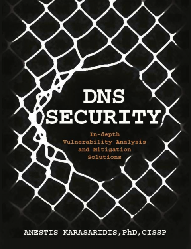
CNIT 40: DNS Security
Fall 2017 Sam Bowne
Scores
77239 T 06:10-09:00PM Moved to MUB 388

|
CNIT 40: DNS SecurityFall 2017 Sam BowneScores
Schedule · Lecture Notes · Projects · Links · Home Page |
Catalog DescriptionDNS is crucial for all Internet transactions, but it is subject to numerous security risks, including phishing, hijacking, packet amplification, spoofing, snooping, poisoning, and more. Learn how to configure secure DNS servers, and to detect malicious activity with DNS monitoring. We will also cover DNSSEC principles and deployment. Students will perform hands-on projects deploying secure DNS servers on both Windows and Linux platforms.Advisory: CNIT 106 or 201E, or Network+-level understanding of networking. Upon successful completion of this course, the student will be able to:
Textbook"DNS Security" by Anestis Karasaridis, Amazon Digital Services, Inc., ASIN: B007ZW50WE Buy from AmazonFree Kindle Apps QuizzesThe quizzes are multiple-choice, online, and open-book. However, you may not ask other people to help you during the quizzes. You will need to study the textbook chapter before the lecture covering it, and take the quiz before that class. Each quiz is available for one week, up till 8:30 am Saturday. Each quiz has 5 questions, you have ten minutes to take it, and you can make two attempts. If you take the quiz twice, the higher score counts.To take quizzes, first claim your RAM ID and then log in to Canvas here: Live StreamingLive stream at: ccsf.edu/webcasts Live Streaming for KahootsDuring the Kahoots, I'll also stream the class via Zoom. |
Schedule | ||||
|---|---|---|---|---|
| Date | Due | Topic | ||
| Tue 8-22 | 1: The importance of DNS security
| |||
| Tue 9-12 | Proj 1 due Quizzes: Ch 1 & Ch 2 due before class |
2: DNS protocol and architecture
| ||
| Tue 10-3 | Proj 2 & 3 due Quiz Ch 3 due before class |
3: DNS vulnerabilities
| ||
| Tue 10-24 | Proj 4 & 5 due Quiz Ch 4 due before class |
4: Monitoring and detecting security breaches
| ||
| Tue 11-14 | Proj 6 due No Quiz due |
| ||
| Tue 12-5 | Proj 7 due Quiz Ch 5 due before class |
Last class: 5: Prevention, protection, and mitigation of DNS service
disruption
| ||
| Fri 12-15 - Thu 12-21 |
Final Exam available online throughout the week. You can only take it once. | |||
Lecture Notes | |
|---|---|
| Policy · Schedule | |
| 1: The Importance of DNS Security (Updated 8-21-17) · KEY | |
| 2: DNS Protocol and Architecture · KEY · PDF | |
| 3: DNS vulnerabilities · KEY · PDF | |
| 4: Monitoring and detecting security breaches · KEY · PDF | |
| 5: Prevention, protection, and mitigation of DNS service disruption · KEY · PDF | |
| 6: DNSSEC and beyond · KEY · PDF | |
|
Click a lecture name to see it on SlideShare. The KEY links are Apple Keynote files. To use other formats, use Cloud Convert. | |